One thing I like about Facebook is the way it reminds you about things that happened on this date in previous years. Facebook is reminding me these days about different milestones related to the publication of the book Healthcare Kaizen that I co-authored with my friend Joe Swartz.
In this post, I'd like to share a few reflections about the book and the impact it has (or hasn't) had.
As you can see on the Amazon listing, the publication date is listed as 6/23/17 (so the anniversary was actually yesterday). I had a few early “print-on-demand” copies to have on hand at the Lean Healthcare Transformation Summit earlier in June 2012.
After writing Lean Hospitals, I wanted to write something else. A number of people warned me against co-authoring a book with anybody, because it's probably more effort than writing a book on your own and there's a risk that you might end up fighting and losing a friendship. A book is like a startup, so there's basically the same risk in starting a company with a friend or a family member.
But, I'm glad I took the risk and it's been such a pleasure working with Joe over the years. I was highly confident that we'd work well together and that's been the case.
We first chatted about the book in early 2010 at the Society for Health Systems conference where we've often crossed paths. We were both presenting about Kaizen and we talked about the idea of collaborating on a book. Joe had an incredible depth of experience leading the Kaizen culture change at a single health system (Franciscan St. Francis in Indiana). I had experience helping many organizations get started with Kaizen. So, it was a combination of depth and breadth of experience… and a shared connection and mentor in the legendary Norman Bodek. Norman was kind enough to write the introduction for the book.
When people ask me if they should write a book, I usually say this:
If you want to write a book, then you'll probably start writing.
If you feel like you NEED to write a book, then you'll probably finish it.
Joe and I didn't write this book because we did market research or because we detected some trend where Kaizen and daily continuous improvement were about to get really hot and popular. We wrote the book because we wanted to. We finished it because we felt like we NEEDED to write the book. We were certainly PUSHING the idea on healthcare, the idea that it's important, if not necessary, to engage EVERYBODY in continuous improvement.
We hoped people would listen.
By the way, Lean Hospitals came to be because my publisher HAD identified a gap in their product offerings. There were competing books already on the market about Lean or TPS in healthcare, but my publisher didn't have one. Long story short, it was a unique situation where they approached me about writing a book (and then giving me the leeway to write that I felt the need to write).
After our SHS meeting, it took a full year (both of us being busy and all) to really get the wheels turning, getting the book proposal submitted and approved through the publisher and then getting to work with the writing. The book was submitted in the fall of 2011 and came off the presses in June 2012.
Originally, the publisher was going to have the books printed in India. That would have been lower cost (especially for a full-color book), but it would have meant longer shipping lead times and a higher risk of books being stocked out. I lobbied the publisher to have printing done and they relented… books are printed in my home state of Michigan, as it turns out.
As the book was coming out, I had the honor to finally meet, in person, another legend, Masaaki Imai, who had graciously agreed to write the foreword for the book:
Notes from Meeting Masaaki Imai and Hearing Him Talk about Kaizen (Continuous Improvement)
As the book was being released, I did this analysis of the Kaizen improvement examples that were in the book after somebody asked me how many were about safety and other goals other than cost.
Analyzing the Kaizen Improvements in Our Book “Healthcare Kaizen”
The Kindle version of the book was released in July. It was the first time I had seen what they call a “print replica” edition, which recreates the entirety of each physical page. The format still allows you to search, take notes, and other helpful Kindle-ish things:
“Healthcare Kaizen” Now Available for All Kindle Devices & Apps!
As an experiment, I had engaged a public relations firm for a few months to get the word out about the book and about Kaizen.
I was interviewed on a few radio shows, including this news broadcast from Seattle's KOMO:
You can listen to more radio and podcast appearances here.
Free Chapters in English and Spanish
Before long, somebody volunteered to translate the freely available chapter 1 PDF into Spanish:
That chapter is still available when you request chapter 1 in English through our website.
Unlike Lean Hospitals, which has been translated many times, Healthcare Kaizen has not been translated. I guess that's a matter of demand, a topic that I'll come back to later in this post.
Shingo Award
In 2013, we were honored to receive what's sometimes referred to, for books, as “The Shingo Prize,” but the formal name is the “Shingo Research and Professional Publication Award.”
This nice video was made to highlight the role of Joe and the Franciscan leaders and team… a shorter version was played at the award ceremony.
The Executive Guide
Joe and I got a lot of nice feedback about the book. We heard one piece of constructive criticism quite often, basically:
“We love the book, but it's too heavy for an executive to carry on a plane. Can you do a condensed version for them?”
So, thanks to that actual voice of the customer, Joe and I worked to produce the shorter, less-expensive Executive Guide to Healthcare Kaizen edition. It's meant to be a complement to the original book, which is over 400 pages, has a lot of how-to detail, and well over 100 examples.
The Executive Guide focuses more on the “why” — why Kaizen? The first book sort of assumes you've already decided to try building a culture of continuous improvement.The Executive Guide focuses more on the leadership behaviors, at all levels, that are necessary to create this culture. We've ended up recommending that an organization buy many copies of The Executive Guide for leaders and then a small number of the larger book for the Process Improvement team or other internal specialists.
We were honored that Dr. Gary Kaplan, CEO of Virginia Mason Medical Center, wrote the introduction for this book:
Dr. Gary Kaplan's Introduction to “The Executive Guide to Healthcare Kaizen”
Impact of the Books?
It's hard to gauge the impact of the book. Again, we felt like we were pushing the idea of Kaizen as opposed to reacting to pull for a book on this topic.
In recent years, there is FAR more talk about daily continuous improvement and I see more evidence of daily Kaizen in healthcare organizations. It's been great to have the opportunity to speak about Kaizen, host workshops and site visits, and do consulting related to Kaizen in healthcare.
When we wrote the book, it seemed most people thought Kaizen was an event – as in Rapid Improvement Event. As we discuss in the book, RIEs are great… but not every improvement needs to be a project or an event.
We don't know how much of that shift is due to our book and how much is due to other great discussion of broader “Daily Lean Management” approaches. Kaizen is a core part of that approach as Kaizen is a core part of Lean, in general.
Joe and the folks at Franciscan St. Francis have extended their approach from “just Kaizen” (which has been wildly helpful for them) to a more complete “Managing for Daily Improvement” approach. We'll talk about that soon in a new podcast, following up on this first podcast we did together:
Joe Swartz Discusses Healthcare Kaizen and a Culture of Continuous Improvement in Hospitals
We figured the book would be a harder sell than Lean Hospitals. For one, there are probably far more people searching for a broader term like “Lean” than they are looking for “Kaizen” or continuous improvement.
We can confirm this by looking at public Google Trends data.
For one, there's “not enough data” for the phrase “Healthcare Kaizen.” People aren't searching for it.
But what about a broader search like “healthcare continuous improvement?” Same thing.
There are more searches for “Lean Hospitals” and “Lean Healthcare.”
Maybe I should have called the book Lean Healthcare instead of Lean Hospitals? Oh well.
The data also begs the question of whether we hit “peak Lean healthcare” in 2012 since the red line goes down since then?
I can see the sales data that's provided to me each week through Amazon… and you see that Lean Hospitals has been a far bigger seller. The red and yellow lines are the 2nd and 3rd editions of Lean Hospitals. The blue and purple lines are the Healthcare Kaizen books. You can see those books barely register with the scale of the graph being set by Lean Hospitals.
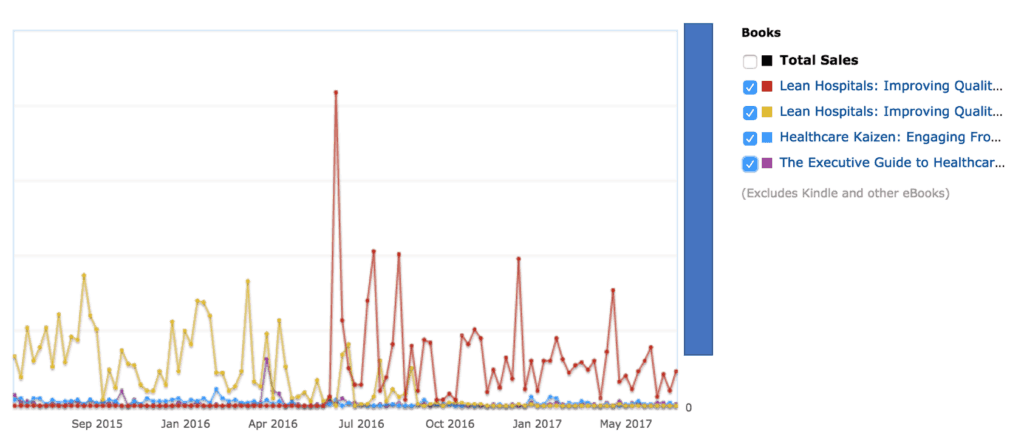
There are many weeks when ZERO copies of the Healthcare Kaizen books are sold. That's disappointing.
One thing that's interesting is that the Healthcare Kaizen books website gets about six times MORE traffic than the Lean Hospitals book website (by recent numbers). Over the longer term, it's about a 4X difference, as you can see in the two charts below:
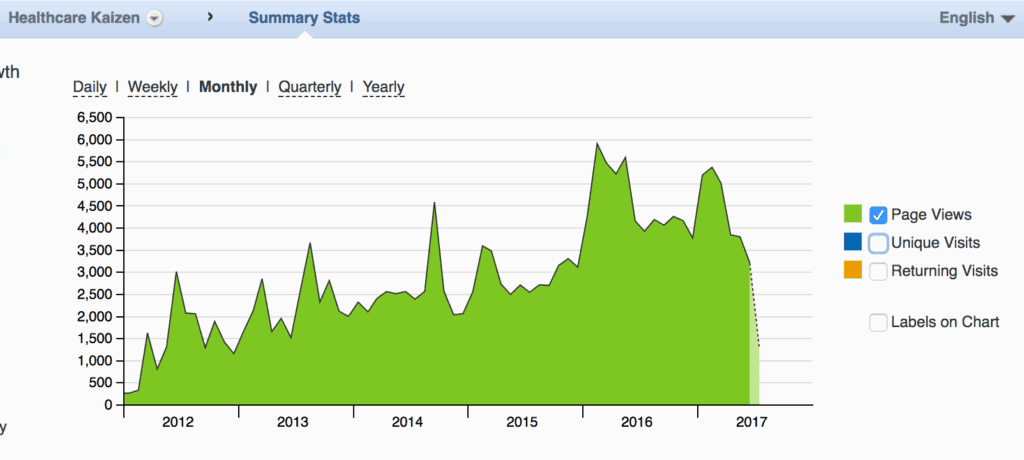
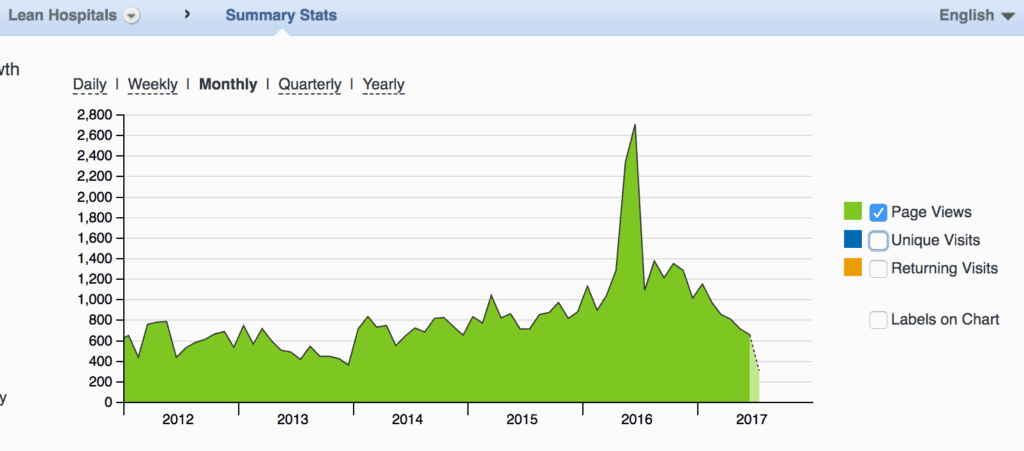
I don't know the reason for the 2016 spike in Lean Hospitals book website traffic.
Some popular pages and features on the Healthcare Kaizen books website include pages that share examples of Kaizens, the Kaizen definition page, downloads of free Kaizen templates, examples of Kaizen boards, and the free chapter downloads.
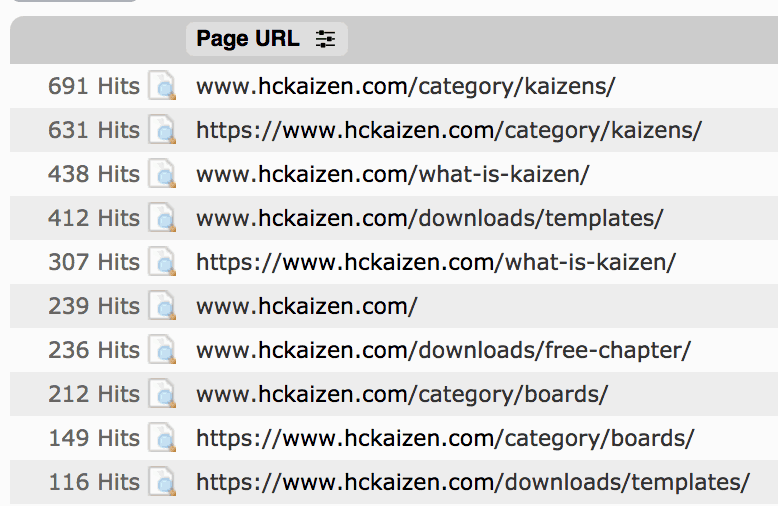
Why Are Healthcare Kaizen Sales Low?
Why don't the Healthcare Kaizen books sell more? This isn't about author royalties to me… it's about spreading ideas that I think are good and helpful.
I think price is a part of it. People complain to me sometimes about how expensive the books are. The prices are set by the publisher. They have to consider the printing cost and their needed profit margin. The book is 400 pages and color printing is expensive… Joe and I asked for the color printing.
We didn't get voice of the customer feedback to tell us if color images are more helpful than black and white for the Kaizen examples and their embedded photos.
I feel bad that the price goes up a few dollars each year and I argue with the publisher over that one, to no avail. It's harder for people (or their organization) to justify a book that's almost $70, I realize.
What are your thoughts on any of this, whether you've read the book or not?
If you have read the book, has it helped you and your organization? We'd love to hear from you.
What do you think? Please scroll down (or click) to post a comment. Or please share the post with your thoughts on LinkedIn – and follow me or connect with me there.
Did you like this post? Make sure you don't miss a post or podcast — Subscribe to get notified about posts via email daily or weekly.
Check out my latest book, The Mistakes That Make Us: Cultivating a Culture of Learning and Innovation:



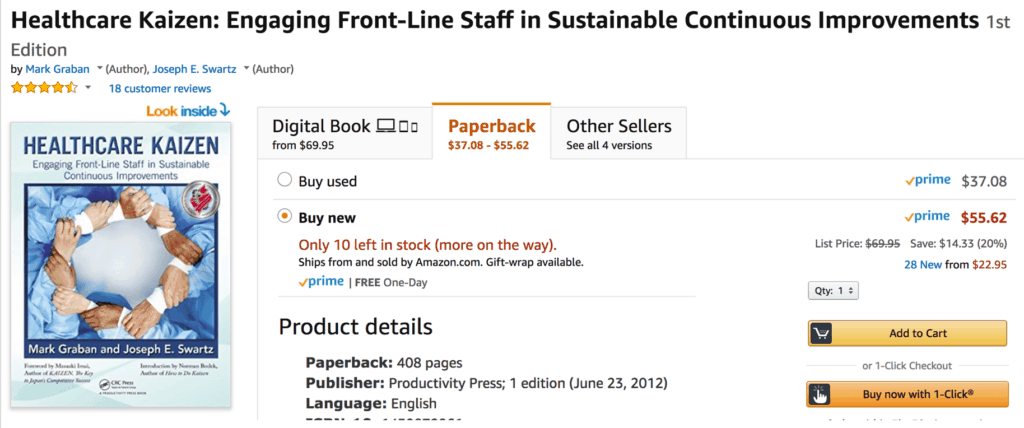







Do you think the growing interest in Toyota Kata has impacted the book?
The book has helped me tremendously. However, applying the principles has been a hard sell in the federal government.
Impacted the book’s sales in what way? I’m not seeing too much more evidence of Kata in healthcare. There are pockets of it, much as we have pockets of Kaizen. This shouldn’t feel like competing methodologies – we have much to learn from both and the approaches have some common themes.
You mentioned that there is far more talk about daily continuous improvement and you have seen more evidence of daily kaizen in healthcare organizations. It seems as if kaizen lays the foundation for kata. I would assume that a kaizen culture would lead to the practice and experimentation associated with kata. Kata is about deliberate practice of the scientific method, and seems to be a natural progression of kaizen. Therefore, instead of jumping right into kata have you seen healthcare organizations start with kaizen and get started by reading Healthcare Kaizen?
Good questions. I’m not sure if I can generalize. I’ve seen experiments with Toyota Kata at ThedaCare where it seemed to be built upon a foundation of daily continuous improvement (or Kaizen). I’ve seen some organizations where it seems like they do Toyota Kata instead of daily Kaizen.
How would you see things fitting together? I could see using Toyota Kata around team goals… we need to improve patient satisfaction, so let’s use a Toyota Kata approach.
The method would be overkill for some things that could use a “quick and easy kaizen” approach — let’s try moving that printer over there.
Is PDCA/PDSA a common thread? They’re both versions of scientific thinking?
Last week, at the Lean Coaching Summit, John Shook talked about why he uses the term “scientific thinking” as a broader term that’s not specifically the “scientific method.” I think he’s making the case that Lean (and therefore Kaizen and Kata?) are not strictly “the scientific method” which was a specific structure…
I agree that some improvements don’t need to be overcomplicated and can be completed by using “quick and easy kaizen.” Let’s move our work areas to one area, where we can better communicate, and reduce motion waste. Let’s use bubbles to reduce children’s discomfort during tests and procedures. If people have good ideas let them test them. Are they all strategically aligned? Do they all have a big impact? Is there a business case for doing them?
Do all improvements need to have a “big impact?” Do they all need to have a “business case” (meaning from a $$$ or ROI perspective?”
I’d argue NO is the answer to both questions.
Answering YES to those questions stifles participant and gets in the way of creating that culture of continuous improvement.
I also argue NO to those questions. All too often the case for not doing kaizen or small just do it type improvements is they don’t address those things ($$$, ROI, Speed, Quality). If our mindset is strictly mechanistic (action item list) aimed at achieving results, we are missing out on so much, and it undermines employees potential.
Toyota Kata should be tied to a larger challenge. Something that gets up in your throat. Reduction in patient falls, reduction in door to balloon time, reduction in patient ER wait time…
I think PDCA/PDSA scientific thinking is thread that ties all types of improvements together (A3 thinking, Kaizen, kata, even larger scale projects). That was a great observation by John Shook.
Congrats for the success of the books, Mark. They have been a great resource for me and many others over the years.
Thanks, Dean, although I still worry about what “success” means. I’m glad they have been useful for you and thanks again for helping me get the opportunity to write Lean Hospitals.